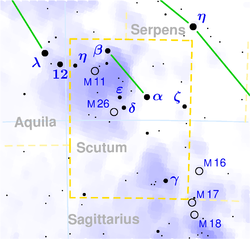- Delta Scuti
-
δ Scuti Observation data
Epoch J2000 Equinox J2000Constellation Scutum Right ascension 18h 42m 16.4268s[1] Declination −09° 03′ 09.175″ Apparent magnitude (V) 4.72[2] Characteristics Spectral type F2IIIp U−B color index +0.16[2] B−V color index +0.35[2] Variable type Delta Scuti Astrometry Radial velocity (Rv) −44.8[3] km/s Proper motion (μ) RA: 7.87[1] mas/yr
Dec.: 2.02[1] mas/yrParallax (π) 17.44 ± 0.80[1] mas Distance 187 ± 9 ly
(57 ± 3 pc)Absolute magnitude (MV) 0.91[4] Details Surface gravity (log g) 3.5[5] Temperature 7,000[5] K Rotational velocity (v sin i) 25.5[5] km/s Other designations Delta Scuti (δ Sct, δ Scuti) is a white, F-type giant star in the constellation Scutum. It is approximately 187 light years from Earth. Delta Scuti is the prototype of the Delta Scuti type variable stars. It is a high-amplitude δ Scuti type pulsator with light variations of about 0.15 minutes. It has peculiar chemical abundances that are similar to those of Am stars.[5]
In 1900, it was discovered that this star had a variable radial velocity by William W. Campbell and William H. Wright using the Mills spectrograph at the Lick Observatory.[7] The 0.19377 day period of this variability as well as 0.2 magnitude changes in luminosity demonstrated in 1935 that the variability was intrinsic, rather than being the result of a spectroscopic binary.[8] In 1938, a secondary period was discovered, and pulsation theory was proposed to model the variation.[9] Since then, observation of Delta Scuti has shown that it pulsates in multiple discrete radial and non-radial modes. The strongest mode has a frequency of 59.731 μHz, the next strongest has a frequency of 61.936 μHz, and so forth, with a total of eight different frequency modes now modeled.[10]
This star has two optical companions. The first is a +12.2 magnitude star located is 15.2 arcseconds from Delta Scuti. The second is a +9.2 magnitude star that is 53 arcseconds away.[11]
References
- ^ a b c d Perryman, M. A. C. et al. (1997). "The Hipparcos Catalogue". Astronomy & Astrophysics 323: L49–L52. Bibcode 1997A&A...323L..49P
- ^ a b c Johnson, H. L.; Iriarte, B.; Mitchell, R. I.; Wisniewskj, W. Z.; Mitchell; Iriarte; Wisniewski (1966). "UBVRIJKL photometry of the bright stars". Communications of the Lunar and Planetary Laboratory 4 (99): 99. Bibcode 1966CoLPL...4...99J.
- ^ Evans, D. S. (June 20–24, 1966). "The Revision of the General Catalogue of Radial Velocities". In Batten, Alan Henry; Heard, John Frederick. Determination of Radial Velocities and their Applications, Proceedings from IAU Symposium no. 30. University of Toronto: International Astronomical Union. http://adsabs.harvard.edu/abs/1967IAUS...30...57E. Retrieved 2009-09-10.
- ^ Antonello, E.; Mantegazza, L.; Mantegazza (November 1997). "Luminosity and related parameters of δ Scuti stars from HIPPARCOS parallaxes. General properties of luminosity". Astronomy and Astrophysics 327: 240–244. Bibcode 1997A&A...327..240A.
- ^ a b c d Yushchenko, A.; et al. (May 2005). "The chemical composition of δ Scuti". Monthly Notices of the Royal Astronomical Society 359 (55): 865–873. Bibcode 2005MNRAS.359..865Y. doi:10.1111/j.1365-2966.2005.08921.x.
- ^ "V* del Sct – Variable Star of delta Sct type". SIMBAD. Centre de Données astronomiques de Strasbourg. http://simbad.u-strasbg.fr/simbad/sim-basic?Ident=V*+del+Sct. Retrieved 2009-10-23.
- ^ Campbell, W. W.; Wright, W. H. (1900). "A list of nine stars whose velocities in the line of sight are variable". Astrophysical Journal 12: 254–257. Bibcode 1900ApJ....12..254C. doi:10.1086/140765. Listed as 2 Scuti on p. 256.
- ^ Colacevich, A. (August 1935). "On the Variable Radial Velocity of δ Scuti". Publications of the Astronomical Society of the Pacific 47 (278): 231–232. Bibcode 1935PASP...47..231C. doi:10.1086/124599.
- ^ Sterne, T. E. (March 1938). "The Secondary Variation of δ Scuti". Astrophysical Journal 87: 133–150. Bibcode 1938ApJ....87..133S. doi:10.1086/143913.
- ^ Templeton, Matthew R.; et al. (October 1997). "A New Pulsation Spectrum and Asteroseismology of delta Scuti". The Astronomical Journal 114: 1592–1601. Bibcode 1997AJ....114.1592T. doi:10.1086/118590.
- ^ Burnham, Robert (1978). Burnham's celestial handbook: an observer's guide to the universe beyond the solar system. 3. Courier Dover Publications. p. 1746. ISBN 0486236730.
External links
Bayer List Categories:- Bayer objects
- Scutum constellation
- Delta Scuti variables
- F-type giants
Wikimedia Foundation. 2010.

